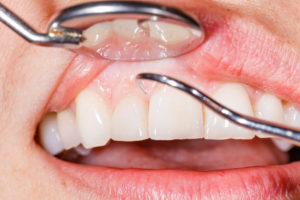Are you at risk for periodontal disease?

Periodontal diseases are infections that affect the gum lining of the teeth and also the bones that surround the teeth. Inflammations and infections result in the gums result in a person getting this disease. The earlier stages of this disease are a gum infection, where the gums become swollen and inflamed. Some also experience bleeding from these infected gums. When this situation gets out of hand, the gum lining is pulled away from the teeth and there is serious issue with bone loss. This disease is mostly seen in adults and is a major dental problem in many.
Infection in the mouth starts with plaque formation. This is a thin layer that later hardens to form the tartar. When this situation occurs, the teeth get affected by the tartar formation and slowly start to decay. This decay spreads to the gum lining and starts affecting the tissues and gums become swollen. Daily brushing and flossing will help to arrest plaque formation, but when it reaches the tartar stage, then it can be removed with help from a dentist.
Risk factors of periodontal disease
Smoking
Smoking and tobacco usage is one of the contributing factors to many dental problems. This habit also contributes to periodontal disease and its progression. Smoking and the use of tobacco affect the immune system in the body. They attack the system and make it weak. This makes the body weak in fighting infections in the gums. It also affects how fast the gums heal with treatment. A person who smokes has twice the amount of risk than a non-smoker. When dental health deteriorates it is easier for infection to progress. From inflamed bleeding gums it progresses to various periodontal diseases.
Poor dental hygiene
Daily brushing and flossing help to keep away infections from the oral region. Food debris often remains in the mouth long after the food is consumed if the mouth is not properly cleaned. Bacteria attack the food debris in the mouth and bring in infections. They work on the dental enamel and also the gums lining and weaken the tooth and the surrounding tissues. By thorough cleaning, the chances of having an environment where the bacteria can act on are being removed. If there is no proper oral hygiene then it is a very favourable environment for bacterial action and diseases.
Heredity
Studies have shown that genetics and periodontal diseases are linked. These disease causing genes can be passed on via genes from one generation to another. The presence of these genes makes a person susceptible to these diseases. If even there are good oral hygiene practices, this disease can set in. There tests available and dentists will also be able to guide a person in this situation by giving them guidance on how to take care of oral health and get early intervention. Some genes influence aggressive periodontal diseases in which there is a great loss of bone structure, so it is important that proactive treatment be planned.
Diabetes
Diabetes is uncontrolled blood sugar levels. This leads to higher glucose levels in mouth liquids as well. Flow of blood is also at a reduced level. The flow of nutrients and removal of wastes does not happen properly. Due to this the gums and bone will also be affected due to reduced blood flow. All these issues lead to more chances of infection in the mouth. On the other hand, when there are untreated periodontal diseases, it also causes increase of blood sugar level and leads to more infection and rapid progression of the disease condition.
Medications
Many need to take medications for a long time and some of the medicines reduce the amount of saliva in the mouth. Dry mouth condition results and along with an increase in bacteria in the oral cavity. Medications such as oral contraceptives, depressants are examples of such medications. Lack of saliva keeps the bacteria away from washing away naturally and the infections have nigh chances of multiplying. These conditions are discussed with the dentist for proper care.
Signs of periodontal disease and prevention procedure
The above risk factors of periodontal disease also point to the signs and symptoms of these diseases. Dry mouth and bad breath are some of the initial symptoms that can potentially progress to this disease. Swollen red gums that seem to pull away from the teeth and expose them are also seen when the disease is at the initial stage. Bleeding is seen when brushing and also while chewing food in some. Changes in how the teeth come together when biting, changes in position or fitting of dentures also point towards periodontal diseases.
Prevention of this disease is easily possible as much of it depends on personal oral hygiene. Brushing and flossing will remove any food that is stuck in the mouth and remove bacterial action. It has been noticed that sometimes even with proper brushing there are chances of plaque getting hardened. In these situations help from the dentist is needed. Regular dental consultations twice a year and cleaning will help in maintaining a clean mouth and jaw and remove any deposits of plaque. There will be no build-up of bacteria and the chances of periodontal diseases are removed.
Scaling is the main non-invasive treatment along with oral antibiotics to remove the infection. If the disease has escalated, then surgery is recommended by dentists. Removing or closing the flap of gum tissue that has been pulled away from its original position in one method of treatment. Grafting of tissues or bone is also done if there is a loss of gum lining or loss of bone due to periodontal disease. Based on the extent the disease has spread, the dentists will recommend the right course of treatment.
